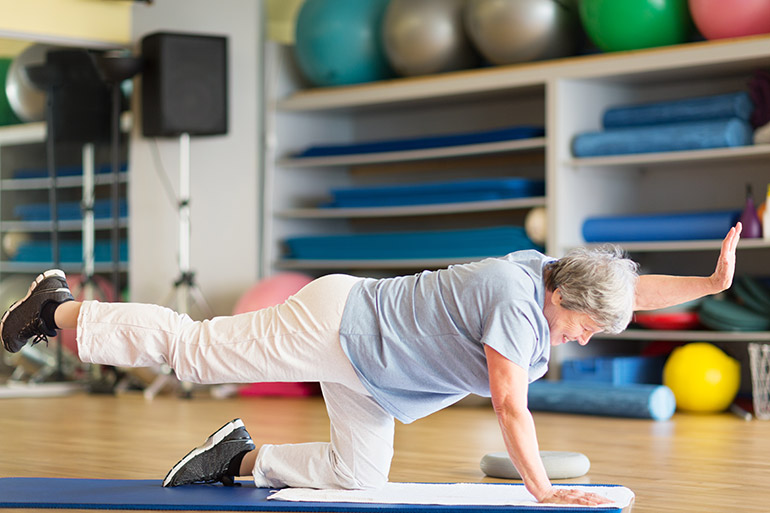
Collective evidence suggests exercise can reduce fall rates in older adults by 21 per cent.
Fall prevention key to keeping older adults healthy and saving health care dollars
Dr. Jennifer Davis, along with many UBCO researchers, spends much of her time looking for ways to keep our older adult population healthy. An assistant professor in the Faculty of Management, her goal is to improve the quality of life of older Canadians through health-economic evaluations and health-outcomes research.
Much of her work looks at fall prevention and keeping older adults functioning independently. As co-director of operations of the Falls Prevention Clinic at Vancouver General Hospital, she discusses the importance of healthy aging as well as the health and cost-implications of falls to older adults.
You recently published a paper in Maturitas examining the risk factors for recurrent falls in older adults. Can you explain why falls are so dangerous for older adults?
Falls, and injuries resulting from falls, represent a significant health burden for older adults as well as their families and caregivers. About one-third of adults aged 65 years and older experience at least one fall annually with half of these people falling more than once a year.
In fact, falls in older adults are the third leading cause of chronic disability. About 95 per cent of hip fractures are associated with a fall, and 10 to 15 per cent of emergency department visits for those aged 65 years and older-most often hip, wrist or spine-are related to a fall.
Non-fatal fall injuries are associated with decreased functional independence, such as the ability to carry out daily activities, lower quality of life, decreased mobility and increased risk of a future fall-related injury.
Your research points out it's not just a matter of balance and mobility. What are the other factors that lead to falls?
The risk of falling increases with age. Women also experience fall-related fractures, such as the hip, wrist or spine, at almost twice the rate of men. Factors that lead to falls include issues such as impaired mobility and balance, taking multiple medications-sometimes four or more-and neuromuscular and sensory impairments. Other areas of concern include medical co-morbidities, environmental factors such as indoor and outdoor tripping hazards, psychological factors and sociodemographic factors.
One of your recent studies examines adherence to a strength and balance retraining exercise program for older adults. Can you explain why such a program is beneficial when it comes to preventing falls?
Collective evidence suggests exercise can reduce fall rates in older adults by 21 per cent. When exercise interventions include balance exercises for at least three hours per week, there is an even greater reduction in the rate of falls.
A home-based exercise program, the Otago Exercise Program, has demonstrated a 36 per cent reduction in the rate of falls among those who have already experienced a fall and a similar 40 per cent reduction in the rate of falls for first-time fallers.
Yet, adherence to exercise is often 50 per cent or lower. We recently found that cognitive processes-including executive function of set-shifting, attention and short-term memory, along with functional mobility-predict exercise adherence. Further research needs to explore how modifying these factors may promote adherence to exercise and thus, contribute to fall prevention.
While healthy aging and independence are vital, can you explain the economic side to keeping our older adults safe?
Ultimately, a goal of identifying the economic burden of falls is to inform future policy decisions regarding investment or disinvestment. To adequately address falls and the burden of fall-related injury, it is essential to first quantify the burden of falls and then establish evidence of the value for money of effective fall prevention strategies. I've previously demonstrated the best value for money comes from targeting prevention towards high-risk groups.
Specifically, three proven cost-saving strategies for falls include: 1) a multi-level program targeted those with higher risk factors for falling was cost saving; 2) the Otago Exercise Program was cost-saving when delivered to people aged over 80 years; and 3) a home safety program was cost-saving for those recently discharged from hospital, if delivered to older adults who sustained a previous fall.
Can you highlight some basic tips that will help keep our elderly population healthy?
Here are a few important healthy aging tips to keep in mind.
- Exercise: Regular exercise helps maintain strength and balance. A little bit of exercise every day can provide many benefits, especially exercises that focus on leg and core strengthening, like balancing on one foot. A physician or physical therapist can provide guidance and information about local exercise classes
- Medication review: Some medications can increase the risk of falls due to side effects such as dizziness or drowsiness, or drug interactions. Review medications with your family doctor regularly.
- Vision assessment: A regular visit to an eye doctor will ensure eye prescriptions are up to date. Bifocals may increase your risk of falling.
- Home safety assessment: Older adults are advised to avoiding walking in socks or stockings and to keep rooms well lit and free of clutter. Safety equipment-such as railings on both sides of stairways, grab bars by the shower, tub and toilet in the bathroom-should be installed.
- Safe footwear: A good way to prevent slipping is to wear rubber-soled shoes or shoes with good traction and use handrails when available.
About UBC's Okanagan campus
UBC's Okanagan campus is an innovative hub for research and learning founded in 2005 in partnership with local Indigenous peoples, the Syilx Okanagan Nation, in whose territory the campus resides. As part of UBC-ranked among the world's top 20 public universities-the Okanagan campus combines a globally recognized UBC education with a tight-knit and entrepreneurial community that welcomes students and faculty from around the world in British Columbia's stunning Okanagan Valley.






